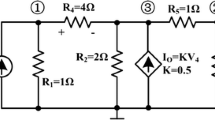Abstract
Testing and diagnosing analog circuits is a very challenging problem. The inaccuracy of measurement and the infinite domain of possible values are the principal difficulties. AI approaches were the base of many systems which tried to overcome these problems. The first part of this paper is a state of the art of this research area. We present two fundamental approaches, model-based reasoning and qualitative reasoning, and the systems implementing them; a discussion and an evaluation of these systems are given. In the second part, we present and propose a novel approach based on fuzzy logic in order to go further in dealing with analog circuits testing and diagnosis. Tolerance is treated by means of fuzzy intervals which are more general, more efficient and of higher fidelity to represent the imprecision in its different forms than other approaches. Fuzzy intervals are also able to be semi-qualitative which is more suitable to the simulation of analog systems. We use this idea to develop a best test point finding strategy based on fuzzy probabilities and fuzzy decision-making methodology. Finally, a complete expert system which implements this approach is presented.
Similar content being viewed by others
References
F. Novak, I. Mozetic, M. Santo-Zarnik, and A. Biasizzor, “Enhancing Design-for-Test for Active Analog Filters by Using CLP(R),” Journal of Electronic Testing: Theory and Applications, Vol. 4, pp. 315–329, 1993.
N. Nagi, A. Chatterjee, and J. Abraham, “DRAFTS: Discretized Analog Circuit Fault Simulator,” in 30th ACM/IEEE Design Automation Conference, 1993, pp. 507–514.
R. Davis and W. Hamsher, “Model-based Reasoning: Troubleshooting,” in H.E. Shorbe and the American Association of AI (Eds.), Exploring Artifcial Intelligence, Chapter 8, Morgan Kaufmann, 1988.
R. Davis, “Diagnostic Reasoning Based on Structure and Behavior,” Aftificial Intelligence, Vol. 24, No. 1, pp. 347–410, 1984.
M. Genesereth, “The Use of Descriptions in Automated Diagnosis,” Artificial Intelligence, Vol.24, No. 1, pp.411–436, 1984.
J. DeKleer and C. Williams, “Diagnosing Multiple Faults,” Artificial Intelligence, Vol. 32, pp. 97–129, 1987.
J. DeKleer, “Focusing on Probable Diagnosis,” Proc. AAAI-91, Anaheim, 1991, pp. 842–848.
P. Struss and O. Dessler, “Physical Negation: Integrating Fault Models into the GDE,” Proc. IJCAI-89, Detroit, 1989, pp. 1318–1324.
M. Gallanti, M. Roncato, A. Stefantini, and G. Tornielli, “A Diagnostic Algorithm Based on Models at Different Level of Abstraction,” Proc. IJCAI-89, Detroit, 1989, pp. 1318–1324.
B. Kuipers, “Reasoning with Qualitative Models,” Artificial Intelligence, Vol. 59, 1993.
J. DeKleer and J.S. Brown, “A Qualitative Physics Based on Confluences,” Artificial Intelligence, Vol. 24, 1984.
K.D. Forbus, “Qualitative Process Theory,” Artificial Intelligence, Vol. 24, 1984.
B. Kuipers, “Qualitative Simulation,” Artificial Intelligence, Vol. 29, pp. 289–338, 1986.
B. Kuipers, “Qualitative Simulation: Then and Now,” Artificial Intelligence, Vol. 59, 1993.
R. Leitch, “Recent Progress in the Development of Qualitative Reasoning,” in IMACS Congress on Math. of the Analysis and Design of Process Control, North-Holland, 1992.
Q. Shen and R. Leitch, “Diagnosing Continuous Dynamic Systems Using Qualitative Simulation,” in 5th National Conf. on Control, 1992.
Q. Shen and R. Leitch, “Application Studies of Fuzzy Qualitative Simulation,” in IMACS Congress on Mathematics of the Analysis and Design of Process Control, North-Holland, 1992.
D. Dubois and H. Prade, Théorie des Possibilités, Masson, Paris, France, 2nd edition, 1987.
P.P. Bonisson and K.S. Decker, “Selecting Uncertainty Calculi and Granularity: An Experiment in Trading-off Precision and Complexity,” in L.N. Kanal and J.F. Lemmer (Eds.), Uncertainty in AI, Elsevier Science Publishers B.V., North-Holland, 1986.
P. Dague, O. Jhel, and P. Taillibert, “An Interval Propagation and Conflict Recognition Engine for Diagnosing Continuous Dynamic Systems,” Lecture Notes in AI, 462, Sept. 1990.
R. Moor, Interval Analysis Series in Automatic Computation, Prentice-Hall, 1966.
P. Dague, O. Raiman, P. Deves, and J.-P. Marx, “DEDALE: An Expert System for Troubleshooting Analogue Circuits,” Proc. IEEE International Test Conference, 1987, pp. 586–594.
F. Pipitone, K. Dejong, and W. Spears, “An AI Approach to Analog System Diagnosis,” in Testing and Diagnosis of Analog Circuits and Systems, R.-W. Liu (Ed.), Chapter 7, Van Nostrand Reihold, New York, 1987.
A. McKeon and A. Wakeling, “Fault Diagnosis in Analogue Circuits Using AI Techniques,” Proc. IEEE International Test Conference, 1989, pp. 118–123.
M. Fares and B. Kaminska, “A Fuzzy Decision-making for Test Space Exploration,” Proc. European Test Conference, Rotterdam, The Netherlands, April 1993, pp. 37–46.
O. Raiman, “Order of Magnitude Reasoning,” Artificial Intelligence, Vol. 51, pp. 11–38, 1991.
P. Dague, P. Deves, P. Luciani, and P. Taillibert, “Diagnostic de Systèmes Analogiques,” in Journées Internationales sur les Systèmes Experts et leur Applications, Avignon, France, 1990.
F. Mohamed, M. Marzouki, F. Novak, and A. Biasizzo, “A Fuzzy Logic Approach for Analog Circuit Diagnosis,” Proc. Int. Mixed Signal Testing Workshop, Grenoble, France, June 1995, pp. 101–106.
C. Cayrol, V. Royer, and C. Saurel, “Management of Preference in Assumption-based Reasoning,” in 4th Int. Conf. on Information Processing of Uncertainty in Knowledge-Based Systems, Palma de Mallorca, Spain, July 1992.
D. Dubois, J. Lang, and H. Prade, “Gestion d'Hypothèse en Logique Possibiliste: Un Exemple d'Application au Diagnostic,” in 10th Conf. on Expert Systems and their Applications, Avignon, France, 1990.
J. DeKleer, “An Assumption-based TMS,” Artificial Intelligence, Vol. 28, pp. 127–162, 1986.
F. Mohamed, M. Marzouki, and M.H. Touati, “FLAMES: A Fuzzy Logic ATMS and Model-based Expert System for Analog Diagnosis,” Proc. European Design and Test Conference, Paris, France, March 1996.
F. Mohamed, M. Marzouki, A. Biasizzo, and F. Novak, “Analog Circuit Simulation and Troubleshooting with FLAMES,” Proc. 14th IEEE VLSI Test Symposium, 1996, pp. 495–500.
Author information
Authors and Affiliations
Additional information
Partly supported by a grant from HIAST, the Syrian Higher Institute for Applied Sciences and Technology.
Rights and permissions
About this article
Cite this article
Mohamed, F., Marzouki, M. Test and diagnosis of analog circuits: When fuzziness can lead to accuracy. J Electron Test 9, 203–216 (1996). https://doi.org/10.1007/BF00137575
Received:
Revised:
Issue Date:
DOI: https://doi.org/10.1007/BF00137575




